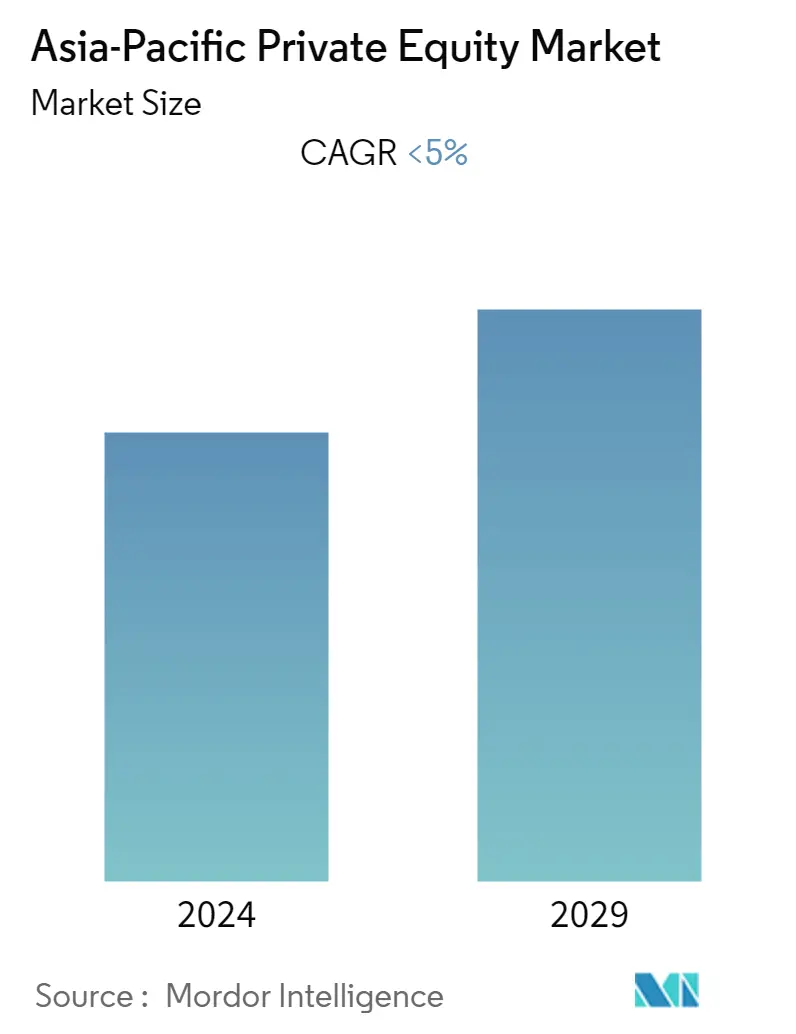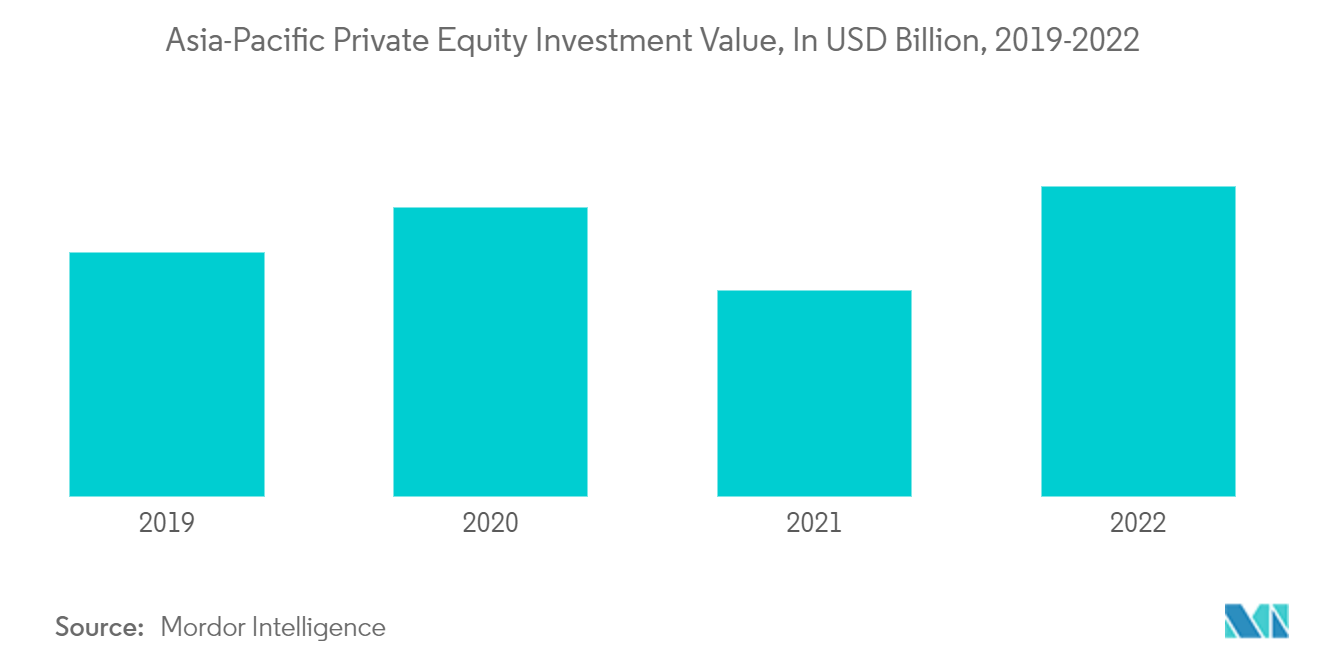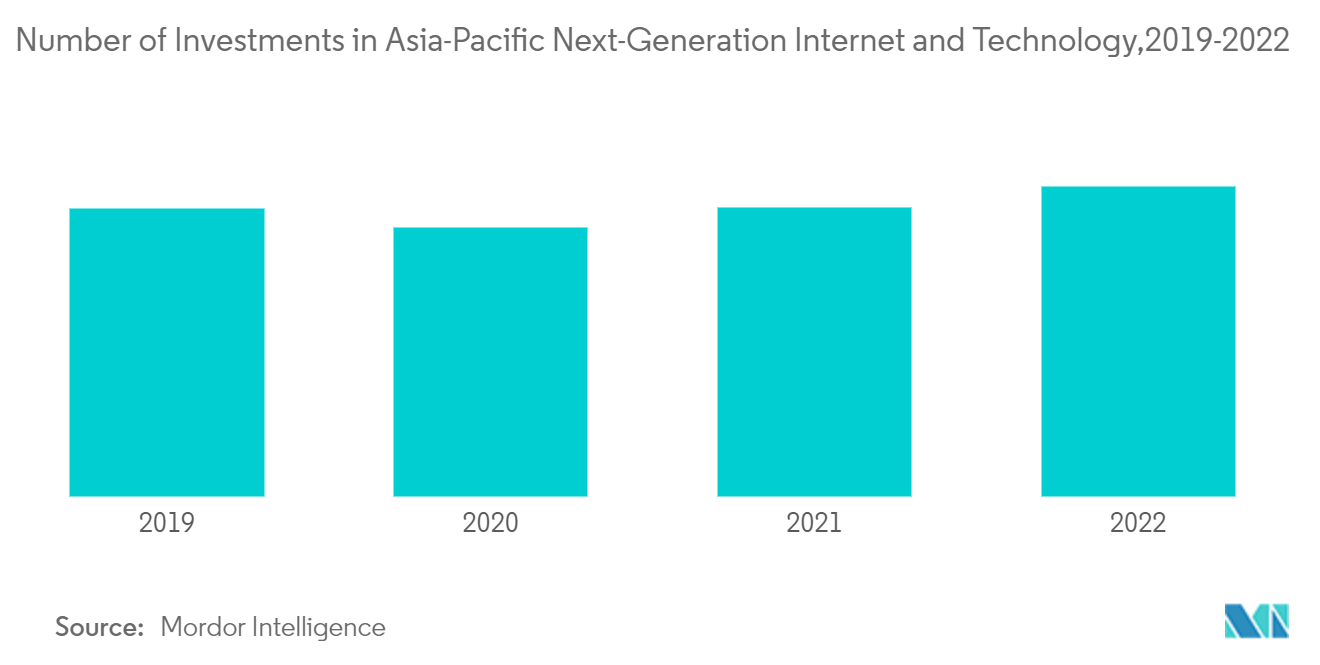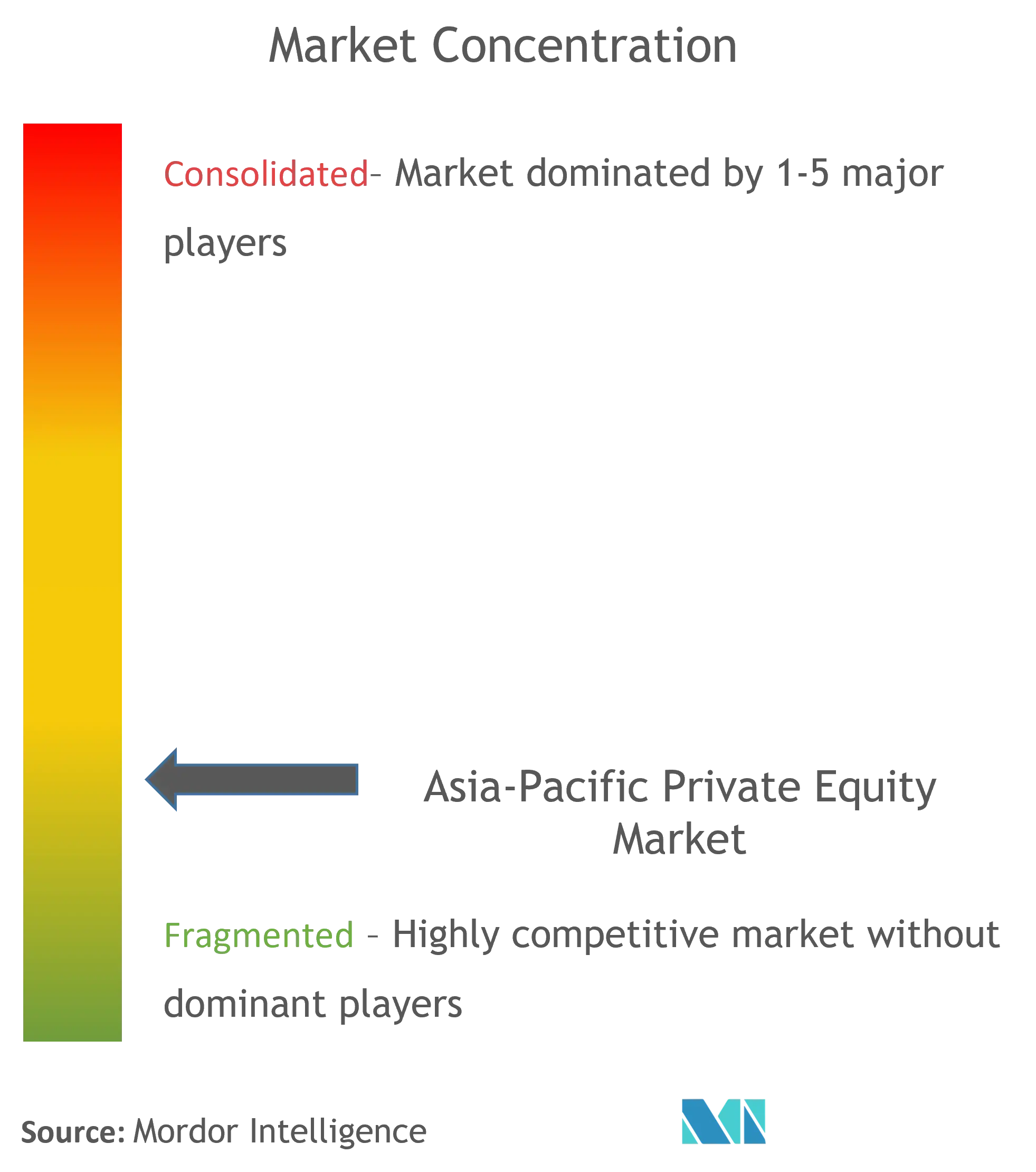Asia-Pacific Private Equity Market Size

| Study Period | 2020 - 2029 |
| Base Year For Estimation | 2023 |
| Forecast Data Period | 2024 - 2029 |
| Historical Data Period | 2020 - 2022 |
| CAGR | 5.00 % |
| Market Concentration | High |
Major Players
*Disclaimer: Major Players sorted in no particular order |
Asia-Pacific Private Equity Market Analysis
The Asia-Pacific Private Equity Market has generated a revenue of USD 198 billion in the current year and is poised to register a CAGR of greater than 5% during the forecast period.
The Asia-Pacific private equity market is a dynamic and rapidly growing industry, encompassing a wide range of investment strategies and sectors. Private equity firms in the region typically invest in companies with strong growth potential, with a focus on sectors such as technology, healthcare, and consumer goods. Private equity firms in the region typically invest across a range of sectors, with technology and healthcare being two of the most popular. Other sectors of interest include consumer goods, financial services, and real estate. In recent years, there has also been growing interest in impact investing and sustainability, with private equity firms looking to invest in companies that can deliver social and environmental benefits alongside financial returns.
The Asia-Pacific private equity market is home to a mix of local and international investors, with both groups increasingly partnering together on deals. Local investors have become more sophisticated and experienced in recent years, with many firms now able to compete on equal footing with international investors. This has led to a growing number of co-investment deals and joint ventures between local and international firms. Regulatory and legal frameworks vary across the region, with some countries having more developed private equity markets than others. However, governments across the region are generally supportive of private equity investment, recognizing its potential to drive economic growth and create jobs.
The COVID-19 pandemic had a significant impact on the Asia-Pacific private equity market. In the short term, deal activity slowed down as investors became more cautious and focused on managing their existing portfolios. However, as the pandemic unfolded, the market began to adapt, and new opportunities emerged. One of the most significant impacts of the pandemic was the acceleration of digital transformation across many sectors. This created new investment opportunities in areas such as e-commerce, digital payments, and telehealth. Private equity firms also started investing in companies that could help other businesses adapt to the new normal, such as those providing remote work solutions and supply chain management. Another impact of the pandemic was the increased focus on healthcare and life sciences. Private equity firms invested in companies that developed treatments and vaccines for COVID-19, as well as those working on other healthcare innovations. The pandemic highlighted the importance of healthcare infrastructure and technology, and this is likely to continue to be a focus for investors in the future. The pandemic also created challenges for some sectors, particularly those that relied heavily on travel and tourism. Private equity firms with investments in these sectors have had to navigate significant challenges and may need to consider restructuring or other measures to ensure the long-term viability of their portfolio companies.
Asia-Pacific Private Equity Market Trends
Deals Made a Remarkable Rebound in Asia-Pacific Private Equity Market
Due to the region's faster economic growth than the rest of the world, the investment climate is favorable. The middle class in the area is expanding quickly, which boosts consumer demand for goods and services and opens up investment prospects. Many businesses in the area are expanding quickly and have great growth potential, especially in industries like technology, healthcare, and consumer products. The availability of capital is another element influencing the rebound in transaction activity. Private equity firms and other investors are searching for appealing investment options after raising substantial amounts of money in recent years. Additionally, the availability of debt financing for agreements has increased as a result of the world's low interest rates, making it simpler and less expensive for businesses to borrow money.
The growing sophistication and maturity of the Asia-Pacific private equity sector have been cited by some industry observers as the reason for the resurgence in deal volume. Local investors are increasingly eager to work with foreign enterprises to utilize their skills and knowledge of the local market, while foreign investors are becoming more able to find and execute more complex and sophisticated projects. Investors are concentrating their investments in the region's fast-growing businesses that have digital platforms and business models that have benefited from the shift to virtual labor, education, and shopping. These sectors are e-commerce, e-learning, digital healthcare, online booking services, online entertainment, digital payments, and financial services.

Asia-Pacific’s Internet and Tech Surge
For nearly a decade, investors have been pouring money into Asia-Pacific's developing Internet and technology sector. The internet economy in Southeast Asia alone was worth over USD 194 billion in the previous year and is anticipated to triple in size by the forecast period. The digital economy in Indonesia and Vietnam is growing at a rate of above 40% on an annualized basis.
Digital payments, e-commerce, and ride-hailing are among the sectors driving rapid development and fueling the rise of "super apps" like Grab, which follows Tencent's WeChat and Alibaba's ubiquity in China across payments and online retail. The digital transformation and value of technology investments at long-standing Asian corporates, particularly the family- or state-owned conglomerates that dominate much of the region, is a big opportunity for private equity funds in this area. The promise in this field is demonstrated by Facebook's recent investment in Jio, India's largest telecoms network. Within 3 years of its launch, Jio, a subsidiary of Reliance Industries, India's largest public corporation, had amassed the greatest customer base of any Indian telecom. That breakthrough is only one illustration of how corporate Asia is undergoing a massive digital transformation. To capitalize on these dynamics, private equity funds in Asia-Pacific have a growing focus on technologies, including software as a service (SaaS), other B2B online services, and e-commerce.

Asia-Pacific Private Equity Industry Overview
The Asia-Pacific Private Equity Market report provides an overview of the major players in the Asia-Pacific private equity market, which is fragmented. Some of the major players in the market are Carlyle, Blackstone, The Everstone Group, KKR, Nippon Sangyo Suishin Kiko Ltd., Bain Capital, Warburg Pincus, J-Star, Ascent Capital, CVC Capital Partners, and others.
Asia-Pacific Private Equity Market Leaders
-
KKR
-
Carlyle
-
The Everstone Group
-
Blackstone
-
Bain Capital
*Disclaimer: Major Players sorted in no particular order

Asia-Pacific Private Equity Market News
- September 2022: The Asian Development Bank (ADB) signed a USD 15 million equity investment in KV Asia Capital Fund II LP, a private equity fund managed by KV Asia to provide growth capital to companies in the health care, financial services, education, manufacturing, business services, and consumer sectors across Southeast Asia.
- July 2022: Malaysia-headquartered private equity firm Navis Capital Partners has launched an Asia Credit Platform, Navis Asia Credit.
Asia-Pacific Private Equity Market Report - Table of Contents
1. INTRODUCTION
- 1.1 Study Assumptions and Market Definition
- 1.2 Scope of the Study
2. RESEARCH METHODOLOGY
3. EXECUTIVE SUMMARY
4. MARKET INSIGHTS AND DYNAMICS
- 4.1 Market Overview
- 4.2 Market Drivers
- 4.3 Market Restraints
-
4.4 Porter's Five Forces Analysis
- 4.4.1 Bargaining Power of Buyers/Consumers
- 4.4.2 Bargaining Power of Suppliers
- 4.4.3 Threat of New Entrants
- 4.4.4 Threat of Substitute Products
- 4.4.5 Intensity of Competitive Rivalry
- 4.5 Insights on Technological Advancements in the Market
- 4.6 Insights on Various Regulatory Trends Shaping the Market
- 4.7 Impact of COVID-19 on the Market
5. MARKET SEGMENTATION
-
5.1 By Investment
- 5.1.1 Real Estate
- 5.1.2 Private Investment in Public Equity (PIPE)
- 5.1.3 Buyouts
- 5.1.4 Exits
-
5.2 By Country
- 5.2.1 China
- 5.2.2 India
- 5.2.3 Japan
- 5.2.4 Singapore
- 5.2.5 Hong Kong
- 5.2.6 Other Countries
6. COMPETITIVE LANDSCAPE
- 6.1 Vendor Market Share
- 6.2 Mergers and Acquisitions
-
6.3 Company Profiles
- 6.3.1 Carlyle
- 6.3.2 Blackstone
- 6.3.3 The Everstone Group
- 6.3.4 KKR
- 6.3.5 Nippon Sangyo Suishin Kiko Ltd.
- 6.3.6 Bain Capital
- 6.3.7 Warburg Pincus
- 6.3.8 J-Star
- 6.3.9 Ascent Capital
- 6.3.10 CVC Capital Partners*
- *List Not Exhaustive
7. FUTURE GROWTH PROSPECTS OF THE MARKET
8. DISCLAIMER
** Subject To AvailablityAsia-Pacific Private Equity Industry Segmentation
In the field of finance, the term private equity refers to investment funds, usually limited partnerships, which buy and restructure financially weak companies that produce goods and provide services. This report aims to provide a detailed analysis of the Asia-Pacific private equity market. Furthermore, it provides an overview of market dynamics, emerging trends in the segments and regional markets, and insights into various product and application types. Moreover, it provides an analysis of the portfolio of key players, along with the competitive landscape in the Asia-Pacific private equity market. The market is segmented by Investment (Real Estate, Private Investment in Public Equity (PIPE), Buyouts, and Exits) and by Country (China, India, Australia, Singapore, Hong Kong, and Other Countries). The report offers the market sizes and forecasts in value (USD) for all the above segments.
| By Investment | Real Estate |
| Private Investment in Public Equity (PIPE) | |
| Buyouts | |
| Exits | |
| By Country | China |
| India | |
| Japan | |
| Singapore | |
| Hong Kong | |
| Other Countries |
Asia-Pacific Private Equity Market Research FAQs
What is the current Asia-Pacific Private Equity Market size?
The Asia-Pacific Private Equity Market is projected to register a CAGR of less than 5% during the forecast period (2024-2029)
Who are the key players in Asia-Pacific Private Equity Market?
KKR, Carlyle, The Everstone Group, Blackstone and Bain Capital are the major companies operating in the Asia-Pacific Private Equity Market.
What years does this Asia-Pacific Private Equity Market cover?
The report covers the Asia-Pacific Private Equity Market historical market size for years: 2020, 2021, 2022 and 2023. The report also forecasts the Asia-Pacific Private Equity Market size for years: 2024, 2025, 2026, 2027, 2028 and 2029.
APAC Private Equity Industry Report
Statistics for the 2024 APAC Private Equity market share, size and revenue growth rate, created by Mordor Intelligence™ Industry Reports. APAC Private Equity analysis includes a market forecast outlook 2029 and historical overview. Get a sample of this industry analysis as a free report PDF download.



